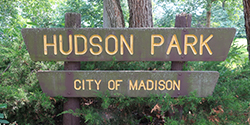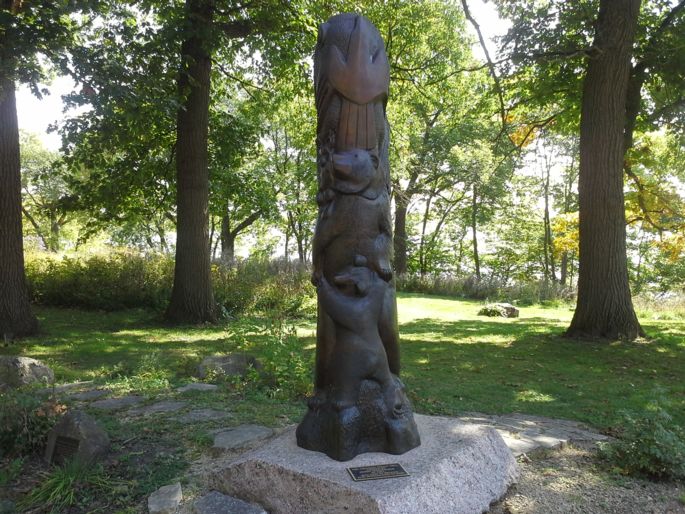Hudson Park

| Address: | 2919 Lakeland Ave. |
| Hours: | 4:00am - 10:00pm |
| Park Type: | Mini |
| Acres: | 4.75 |
| Restroom: | No |
| Drinking Water: | No |
| Shoreline On: | Lake Monona |
Park Details
Hudson Park, located at 2919 Lakeland Avenue, stretches along the shores of Lake Monona and is complete with 4.75 acres of lake views, ancient mounds, and a bronze memorial dedicated to the Ho-Chunk Nation. Native American artist Harry Whitehorse, of the Ho-Chunk Nation, transformed a storm-damaged tree into a memorial honoring his ancestors in 1991. The sculpture, created from the trunk of a hackberry tree struck by lightning, contains carvings of a wolf, bear, cub, lynx, thunderbird, eagle, and a Ho-Chunk warrior and overlooks the burial mounds.After careful restoration, the statue was cast in bronze and rededicated in 2009.

Burial Mound Policy
Created with assistance from the Wisconsin Historical Society and the Ho-Chunk Nation, and approved by the Board of Park Commissioners in October 2019, the policy provides guidelines and procedures for managing burial mounds located in Madison Parks. Burial mound locations are also included in the policy.
At this Park
-
 Canoe & Kayak Launch Site
Madison Parks offers various locations to launch a canoe or kayak and is allowed at all of Madison Parks motorboat launch sites. Additionally, the parks listed below have a specially designated area for launch.
Canoe & Kayak Launch Site
Madison Parks offers various locations to launch a canoe or kayak and is allowed at all of Madison Parks motorboat launch sites. Additionally, the parks listed below have a specially designated area for launch.
If you are looking to store your kayak or canoe in a park, please visit the storage webpage.
View all Canoe & Kayak Launch Sites -
 Fishing
Madison Parks offers seasonal and year-round fishing piers. Year-round locations include Brittingham Park (near shelter), Cherokee Marsh Conservation Park, South (School Road), Olbrich Park (Starkweather Creek), and Spring Harbor Park.
Fishing
Madison Parks offers seasonal and year-round fishing piers. Year-round locations include Brittingham Park (near shelter), Cherokee Marsh Conservation Park, South (School Road), Olbrich Park (Starkweather Creek), and Spring Harbor Park.
An accessible pier is located in Vilas Park, on Lake Wingra and at Warner Park, on the Warner Park lagoon.
Wisconsin residents aged 16 years old or older need a fishing license to fish in any waters of the state. Nonresidents aged 16 years old or older need a nonresident fishing license to fish in Wisconsin waters with hook and line. Visit the Wisconsin DNR website for more information.View all Fishing
Every year, the first consecutive Saturday and Sunday in June and the third Saturday and Sunday in January, are designated as Free Fishing Weekends throughout the state of Wisconsin. Residents and nonresidents of all ages can fish without a fishing license (and trout stamps) over these two days. Visit WI DNR
MESSAGE FROM PUBLIC HEALTH MADISON & DANE COUNTY: Eating fish can be a delicious, low-cost, and nutritious meal. However, eating certain fish can also be harmful because they may contain mercury, PCBs, or PFAS. See PHMDC for more information. -
 Historical Feature
More information on historic buildings or district questions may be found in the Department of Planning & Community & Economic Development Planning Division.
Historical Feature
More information on historic buildings or district questions may be found in the Department of Planning & Community & Economic Development Planning Division.
Wisconsin has the highest concentration of burial mounds in the United States and the Madison area has one of the highest concentrations of burial mounds remaining. Most mounds were lost to 19th-century agricultural practices and city development. The mound builders were farmers who also engaged in hunting and gathering. They lived in small villages and migrated from one to another based on the seasonal availability of natural resources. The mounds often, but not always, have burials associated with them, but their exact purpose is not entirely understood. Mounds tend to have been built in places with beautiful views of the surrounding countryside. The mounds are considered sacred by modern Native Americans and should be treated with respect.
A Burial Mounds Policy was created with assistance from the Wisconsin Historical Society and the Ho-Chunk Nation, and approved by the Board of Park Commissioners in October 2019, the policy provides guidelines and procedures for managing burial mounds located in Madison Parks. Burial mound locations are also included in the policy.-
Elmside Native American Burial Mound
Location: corner of Maple and Lakeland
Built: ca. 700 - 1200 A.D.
Description: Overlooking Lake Monona are two well-preserved animal burial mounds. Referred to for many years as a lynx and a bear, the actual animals or spirits that they were intended to represent is not entirely clear. These mounds were originally part of the same cluster as the Hudson Park mound.
These mounds were designated a City of Madison landmark on May 7, 1990, and are on the National Register of Historic Places.
More Information: Landmark Nomination
-
Hudson Park/Mill Woods Native American Mound
Location: corner of Hudson and Lakeland
Built: ca. 700 - 1200 A.D.
Description: Overlooking Lake Monona is a long-tailed burial mound that has been referred to as a turtle, lizard, panther, and water spirit. Part of the tail was cut off when Lakeland Avenue was constructed. This mound was originally part of a dense and extensive cluster of mounds that extended from the Yahara River to what is now Olbrich Park. The site was still a favored Ho-Chunk campground as late as the late 19th century.
The Hudson Park Mound was designated a City of Madison landmark on May 7, 1990, and is on the National Register of Historic Places.
More Information: Landmark Nomination
-



